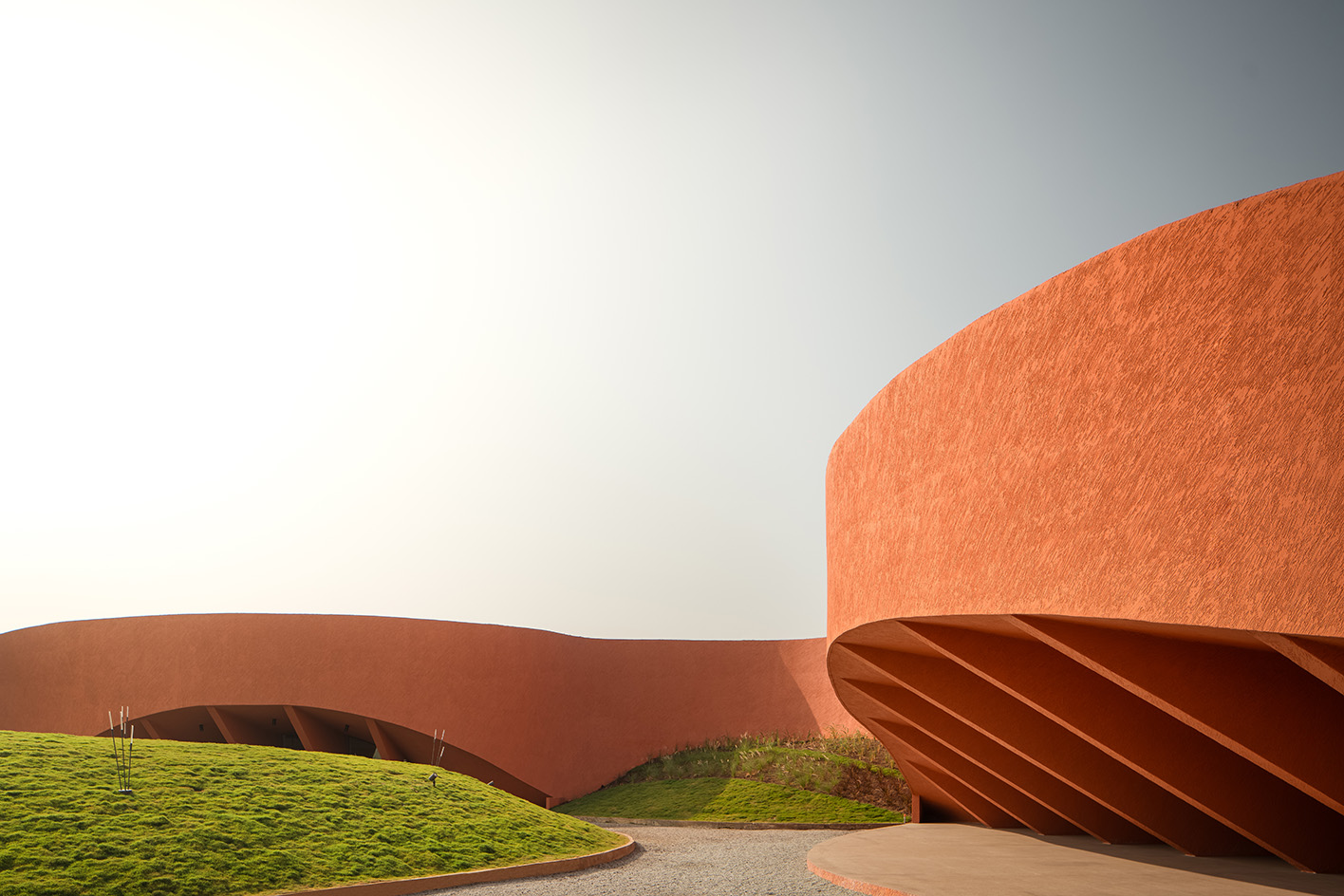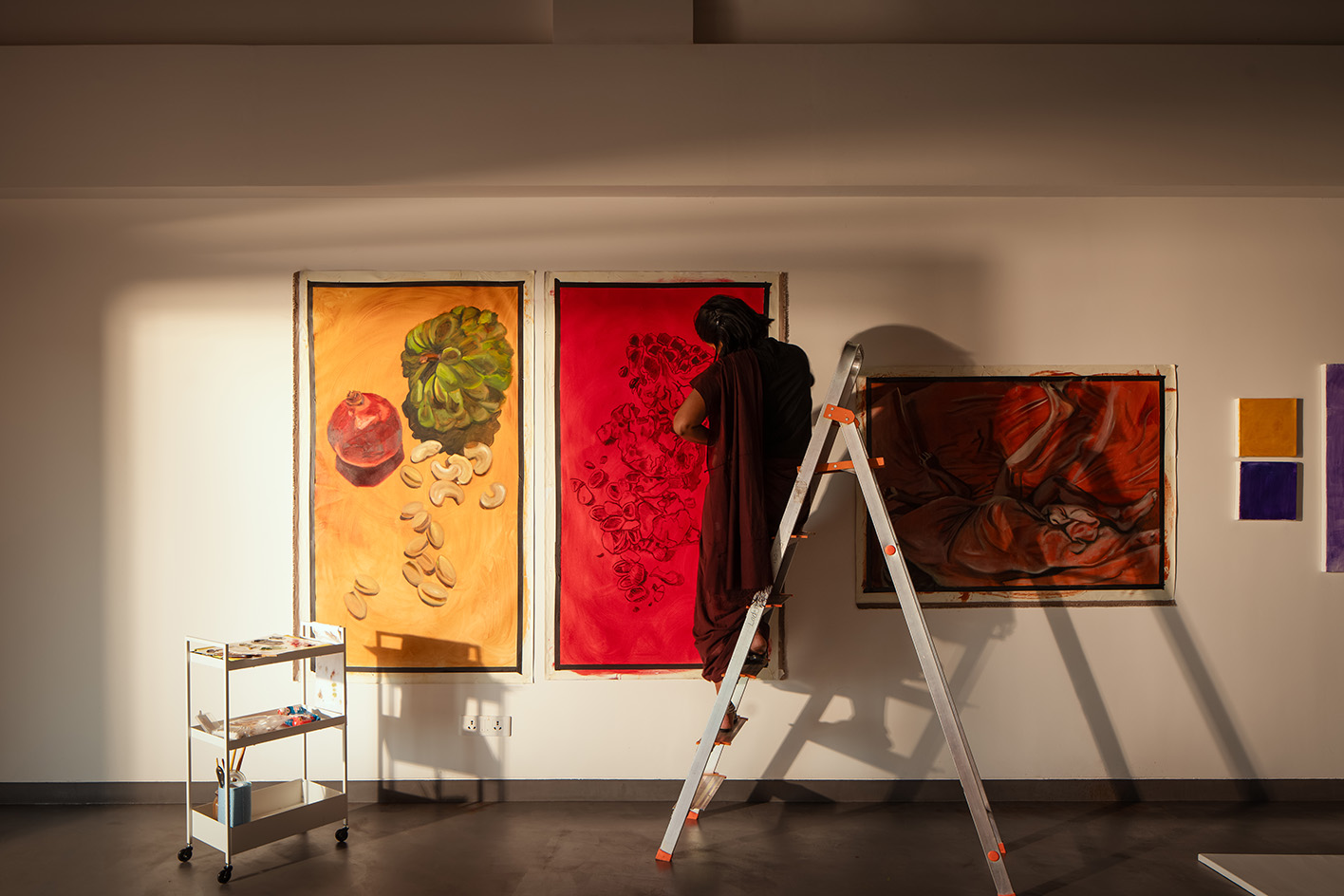India’s Hampi Art Labs is a piece of architecture at one with its content and context
The world-class Hampi Art Labs by Indian architect Sameep Padora, near South India’s Hampi Unesco World Heritage Site, mimics the contours of the nearby Tungabhadra River

When viewed from a distance, Hampi Art Labs could pass for a spectacular riverbank – if a riverbank did such a thing as levitate. Located in southern India near the Unesco World Heritage Site of Hampi, the structure is a sleight of hand by leading Indian architect Sameep Padora (behind numerous Indian houses, such as Lattice House, as well as Wallpaper* Design Awards Best Public Building 2021 Temple of Steps).
Hampi Art Labs undulates with the landscape, echoing the nearby Tungabhadra River and exuding a lightness of being that belies its sculptural proportions. Spread across 18 acres of virgin land, the recently opened arts centre, founded by Sangita Jindal and Tarini Jindal Handa of Indian powerhouse JSW, plays host to exhibition spaces, studios, ceramic and printmaking workshops, gardens, apartments for residencies, and a café.

Hampi Art Labs: a modern building for a storied site
For Padora, the founder and principal of his eponymous Mumbai-based practice, it was important to tread lightly. After all, the city has a storied past. Between the 14th and early 17th centuries, the land today known as Hampi was the roaring capital of the Vijayanagara empire, the last great Hindu kingdom. Its rulers built forts, royal complexes, temples, pillared concourses, memorial structures and waterways, ensuring an architectural legacy that would outlive their reign.
The effort proved fruitful even in the face of invasion, when many structures were ravaged beyond redemption. The ones that survived sit shoulder to shoulder today with the ragged hills and thousands of naturally occurring granite boulders for which Hampi is equally famed.

For a land so exceptional, the architecture had to be equally so, although Padora admits that the point of departure wasn't immediately clear. ‘We deliberated over whether to reference the historic architecture or the barren landscape it sat on, and ultimately decided on the latter. It was important to contextualise the new build to what had endured over the centuries, not what hadn't,’ says Padora.

Nodding to the natural context, each space was designed to hold a mirror to the topography. A case in point is the edifice housing the gallery and studios. Shaped like a meandering river, it echoes the ebb and flow of the activity around. In determining its curvature, Padora took a leaf from urban sociologist Manuel Castells’s ‘space of flows’ concept. ‘The term, in this case, encapsulates all manner of natural occurrences: gravity, percolation, mountainous desire paths. I imagined the people inside in much the same way. The idea was to let them get swept deeper and deeper,’ he says.

Padora envisaged the landscape not as a backdrop for art, but as a work of art itself. This meant treating the roof no differently from the ground, even merging the two with steps that challenge where, or whether, one ends and the other begins. Likewise, the entire exterior, including the roof, is characterised by locally sourced terracotta, and the rooftop walking path is flanked by garden beds that will, in time, grow to cover the hardscape and camouflage it against the surrounding verdure.
Receive our daily digest of inspiration, escapism and design stories from around the world direct to your inbox.

Padora and his team – which included architects Aparna Dhareshwar, Vami Koticha, Kunal Sharma and Aum Gohil – took a similar approach with the artist residences, imagining them as pebbles in a stream amidst courtyards emblematic of water. Each residence is outfitted with a kitchenette, a dining room, a walk-in closet and bathroom, and a living room with a megalithic granite sofa that seemingly grows out of the ground. ‘We exercised both a local sensitivity and a global sensitivity, with native materials variously reimagined in modern forms,’ says Handa, Hampi Art Labs’ creative director.

Padora’s ethos of fluidity went hand in hand with Handa’s, who was firm in her belief that Hampi Art Labs’ world-class residency programme should be open to anyone from anywhere, and indeed it welcomes artists from across the globe. Its inaugural cycle includes Bhasha Chakrabarti of the United States, Promiti Hossain of Bangladesh, and Sharbendu De, Madhavi Gore and Anirudh Singh Shaktawat of India.

Hampi Art Labs’ maiden exhibition, 'Right Foot First', curated by independent curator Phalguni Guliani, is of special note. Borrowing works from the prized Jindal Collection, it presents ensembles of artworks that at once contrast and complement each other, transcending various disciplines, generations and eras. Featured artists include Andy Warhol, Atul Dodiya, Annie Morris, Atul Dodiya, Ai Weiwei, Bharti Kher, BV Doshi, Dayanita Singh, Lubna Chowdhary, Manish Nai, Manu Parekh, Praneet Soi, Reena Saini Kallat, Rohini Devasher, Sayan Chanda, Sheba Chhacchi, Shilpa Gupta, Suhasini Kejriwal, Tushar Joag and Zarina Hashmi.

The current exhibition is designed to echo the overarching architecture by way of curvilinear walkways that represent the philosophical idea that ‘no man can ever step in the same river twice’. It is a metaphor perfectly apt for an arts centre ever evolving, and one expected to be ever in spate.

Hampi Art Labs opens on 6 February 2024 Hampi, India
-
 Robert Therrien's largest-ever museum show in Los Angeles is enduringly appealing
Robert Therrien's largest-ever museum show in Los Angeles is enduringly appealing'This is a Story' at The Broad unites 120 of Robert Therrien's sculptures, paintings and works on paper
-
 The Wallpaper* style team recall their personal style moments of 2025
The Wallpaper* style team recall their personal style moments of 2025In a landmark year for fashion, the Wallpaper* style editors found joy in the new – from Matthieu Blazy’s Chanel debut to a clean slate at Jil Sander
-
 Tokyo’s most cinematic stay reopens as an exercise in architectural self-control
Tokyo’s most cinematic stay reopens as an exercise in architectural self-controlPark Hyatt Tokyo and Studio Jouin Manku demonstrate how design can evolve without erasing memory, balancing modernist heritage with contemporary comfort
-
 A day in Ahmedabad – tour the Indian city’s captivating architecture
A day in Ahmedabad – tour the Indian city’s captivating architectureIndia’s Ahmedabad has a thriving architecture scene and a rich legacy; architect, writer and photographer Nipun Prabhakar shares his tips for the perfect tour
-
 Inside a creative couple's magical, circular Indian home, 'like a fruit'
Inside a creative couple's magical, circular Indian home, 'like a fruit'We paid a visit to architect Sandeep Virmani and social activist Sushma Iyengar at their circular home in Bhuj, India; architect, writer and photographer Nipun Prabhakar tells the story
-
 The Architecture Edit: Wallpaper’s houses of the month
The Architecture Edit: Wallpaper’s houses of the monthFrom wineries-turned-music studios to fire-resistant holiday homes, these are the properties that have most impressed the Wallpaper* editors this month
-
 A refined Indian country residence reimagines the farmhouse
A refined Indian country residence reimagines the farmhouseSet among Karnataka’s rolling fields and forest, House by the Grove by Taliesyn Design & Architecture combines modern materials with an open approach to the elements
-
 Half bridge, half home: Wallmakers’ latest project takes architecture to daring new heights
Half bridge, half home: Wallmakers’ latest project takes architecture to daring new heightsHovering above a forest stream in Maharashtra, Bridge House pushes the limits of engineering and eco-conscious design
-
 The Architecture Edit: Wallpaper’s houses of the month
The Architecture Edit: Wallpaper’s houses of the monthFrom Malibu beach pads to cosy cabins blanketed in snow, Wallpaper* has featured some incredible homes this month. We profile our favourites below
-
 Cascading greenery softens the brutalist façade of this Hyderabad home
Cascading greenery softens the brutalist façade of this Hyderabad homeThe monolithic shell of this home evokes a familiar brutalist narrative, but designer 23 Degrees Design Shift softens the aesthetic by shrouding Antriya in lush planting
-
 A lush Bengaluru villa is a home that acts as a vessel for nature
A lush Bengaluru villa is a home that acts as a vessel for natureWith this new Bengaluru villa, Purple Ink Studio wanted gardens tucked into the fabric of the home within this urban residence in India's 'Garden City'